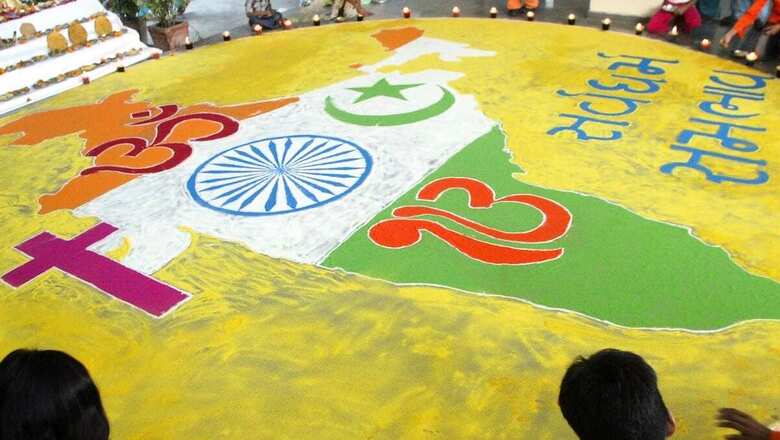
views
Amid an ongoing debate over the status of the Muslim population in India, the Economic Advisory Council to the Prime Minister has published a study this year – with an analysis of global datasets and scenario – that states that minorities are not “just protected but thriving in India”.
According to the paper, titled Share of religious minority – A cross country analysis (1950-2015), “Contrary to the noise in several quarters, a careful analysis of the data shows that minorities are not just protected but indeed thriving in India. This is particularly remarkable given the wider context within the South Asian neighbourhood where the share of the majority religious denomination has increased and minority populations have shrunk alarmingly across countries like Bangladesh, Pakistan, Sri Lanka, Bhutan and Afghanistan. India’s performance suggests that there is a conducive environment to foster diversity in the society.”
The Economic Advisory Council to the Prime Minister (EAC-PM) is an independent body, which advises the prime minister and the government on economic and related issues. Council member Dr Shamika Ravi and two others – Abraham Jose, a young professional, and Apurv Kumar Mishra, a consultant – have done the analysis and written the paper, which was accessed by News18.
The paper analyses global and country-specific data. It said: “It is not possible to promote better life outcomes for the disadvantaged sections of society without providing a nurturing environment and societal support through a bottom-up approach. By way of illustration, India is one of the few countries that has a legal definition of minorities and provides constitutionally protected rights for them. The outcomes of these progressive policies and inclusive institutions are reflected in the growing number of minority populations within India.”
‘India continues harbouring persecuted populations’
The study explains that the Muslim population in India has increased while the percentage of Hindus has dropped over the decades. “In India, the share of the majority Hindu population decreased by 7.82 per cent between 1950 and 2015 (from 84.68 per cent to 78.06 per cent). The share of Muslim population in 1950 was 9.84 per cent and increased to 14.09 per cent in 2015 – a 43.15 per cent increase in their share,” the paper said.
“The share of Christian population rose from 2.24 per cent to 2.36 per cent – an increase of 5.38 per cent between 1950 and 2015. The share of Sikh population increased from 1.24 per cent in 1950 to 1.85 per cent in 2015 – a 6.58 per cent rise in their share. Even the share of the Buddhist population witnessed a noticeable increase from 0.05 per cent in 1950 to 0.81 per cent,” it added.
The researchers, meanwhile, also found out that the share of Jains decreased from 0.45 per cent in 1950 to 0.36 per cent in 2015. The Parsi population has also witnessed a stark 85 per cent decline, reducing from 0.03 per cent in 1950 to 0.004 per cent in 2015.
The paper further showed how Muslims in India have flourished. Minority populations from across neighbouring nations have also come to India when in trouble, it said.
“It is not surprising, therefore, that minority populations from across the neighborhood come to India during times of duress. India has been a nourishing environment for the Tibetian Buddhists who had to escape from China and have found a comfortable home in India in the last six decades,” the paper said.
“Similarly, Matuas who took refuge in India due to religious persecution in Bangladesh have been assimilated into Indian society. India also hosts a significant population of refugees from Sri Lanka, Pakistan, Myanmar and Afghanistan. Given its plural, liberal and democratic nature, India has continued its civilisational tradition of harbouring persecuted populations from several countries over the last six decades,” it added.
‘Demographic transitions underway across countries’
The paper delved deep into factors related to the global economy and demographic transitions. Explaining the global scenario, it said: “The global economy is in a phase of churn and being closely watched and analysed by economists and policymakers everywhere. There are, however, major demographic transitions that are also underway across countries – but mostly going unnoticed by analysts ranging from economy-watchers to democracy-watchers. These silent transformations have the power to reshape societies and states. Ironically, of the four megatrends whose cascading effects are bringing about these transformations – demography, technology, economy and climate change – the forecasts for demography are the most predictable.”
“Shifting demographic trends are aggravating economic disparity within and between countries, straining governance and fuelling friction between states and people. Political changes are mere symptoms of deeper structural changes that are happening in societies due to a variety of transformations, of which demographic evolution is an important component. The composition of populations in countries around the world is changing along several axes that are well-documented such as age, urbanisation and migration levels,” the paper said.
According to the analysis of multiple datasets by the committee, the share of the majority religious denomination has decreased in four countries while its share has increased in five countries.
“All the Muslim majority countries witnessed an increase in the share of the majority religious denomination except the Maldives, where the share of the majority group (Shafi’i Sunnis) declined by 1.47 per cent,” said the document.
“Among the five non-Muslim majority countries, Myanmar, India and Nepal saw a decline in the share of the majority religious denomination while Sri Lanka and Bhutan saw their share increase. The members of SAARC are India, Pakistan, Bangladesh, Afghanistan, Nepal, Sri Lanka, Bhutan and Maldives. The range of the rate change in the share of the majority religion for this region spans from -9.84 per cent for Myanmar (where the share of Theravada Buddhist population fell from 79 to 71 per cent) to 18.55 per cent for Bangladesh (where the Hanafi Muslim witnessed an extraordinary rise from 74 to 88 per cent of the population),” it added.
Stay updated with live coverage of Lok Sabha Election 2024 Phase 3 Voting In Karnataka And Gujarat on our website. Get the latest updates, polling trends, result dates and more.




















Comments
0 comment